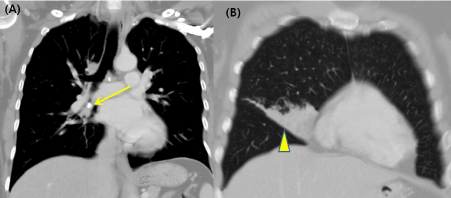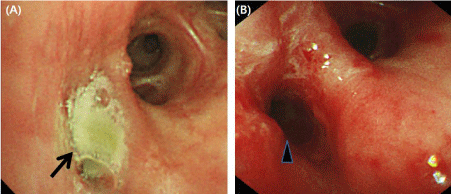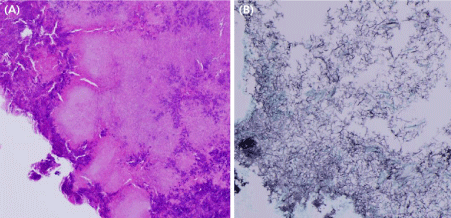
Case Presentation
Austin J Pulm Respir Med 2017; 4(2): 1057.
A Case of Primary Endobronchial Actinomycosis Presenting with a Broncholith that was Cured by Bronchoscopic Removal and Short-Term Antibiotic Treatment
Ahn S, Chang JS, Kim YI*, Kim TK and Shin HJ
Department of Internal Medicine, Chonnam National University Hospital, South Korea
*Corresponding author: Yu-Il Kim, Division of Pulmonology, Department of Internal Medicine, Chonnam National University Hospital, South Korea
Received: November 15, 2017; Accepted: December 15, 2017; Published: December 22, 2017
Abstract
We report a rare case of primary endobronchial actinomycosis presenting as a broncholith that was cured by a combined bronchoscopic and short-term medical treatment.
A 41-year-old woman was admitted to the hospital complaining of dry cough. She had no underlying diseases. Chest computed tomography showed a calcified broncholith with atelectasis at the right middle bronchus. Bronchoscopy revealed about 1cm sized hard broncholith which obstructed the airway. The broncholith was removed using grasping forceps and Actinomyces colonies were detected by pathologic result. After bronchoscopic removal of broncholith and a relatively short term antibiotic treatment (for 6-weeks) the patient achieved clinical recovery.
Endobronchial actinomycosis can be presented as a broncholith that obstruct an airway in a patient without any underlying diseases. In case of a limited endobronchial lesion, it can be cured by bronchoscopic procedure with short-term antibiotic treatment.
Keywords: Primary endobronchial actinomycosis; Broncholith; Bronchoscopy; Antibiotics
Background
Actinomycosis is a chronic supportive infection due to a group of Actinomyces organisms belonging to the resident flora of the various sites; oropharynx, gastrointestinal tract and urogenital tract [1]. Endobronchial involvement is a form of pulmonary actinomycosis that is usually associated with foreign body aspiration [2,3] and that mimics endobronchial neoplasm and tuberculosis [4,5]. However, endobronchial actinomycosis can be developed without any other underlying condition. That is defined as a primary endobronchial actinomycosis which is an extremely rare form of actinomycosis non easily recognizable [4,6]. A broncholith can be produced as a result of chronic inflammation associated with actinomycosis [6] or coinfection with Mycobacterium tuberculosis or Histo plasmacapsulatum [7]. However, the data available in the literature are a few cases due to extremely low frequency of primary endobronchial actinomycosis with a broncholith. Herein, we report a case of endobronchial actinomycosis presenting as a broncholith which was confirmed by pathologic result and which was cured by bronchoscopic removal and relatively short-term antibiotic treatment.
Case Presentation
A 41-year-old woman presented with a 3-months history of cough and intermittent febrile sensation. She had no history of underlying diseases, recurrent infection, foreign body aspiration, or dental problem. Her review of systems was not specific except 8kg body weight loss for 2 months. On physical examination at admission, her blood pressure was 110/70 mm Hg, heart rate 60/min, respiratory rate 20/min and body temperature 36.7ºC. On chest auscultation, decreased breath sounds were heard in the right middle lung field. The initial laboratory findings were as follows: the complete blood count 6,800mm3, hemoglobin 12.4g/dl, platelet count 225,000/mm3, sodium 140 mEq/L, potassium 4.3 mEq/L, blood urea nitrogen 11.6 mg/dL, creatinine 0.6 mg/dL, aspartate aminotransferase 21 IU/L, alanine aminotransferase 11 IU/L, total protein 7.3 g/dL, albumin 4.1 g/dL, glucose 84 mg/dL and C-reactive protein 0.44 mg/dL. Chest X-ray showed an endobronchial calcified nodule with partial distal atelectasis of the right middle lobe suggesting a broncholith (Figure 1-A,B). On bronchoscopy, about 1x1 cm sized, yellowish hard broncholith was seen at the opening of right middle lobe bronchus (Figure 2-A). The broncholith was successfully removed using grasping forceps and no complication was observed (Figure 2-B). Bronchial aspirate taken from right middle lobe which was negative for acid fast bacilli and no organism was grown on culture.
The pathology results of endobronchial calcified nodule showed sulfur granules (representing Actinomyces colonies) which were characterized by a zone of granulation tissue surrounding one or more oval granules (Figure 3-A). They were much denser in the peripheral portion than center. In methenamine-Silver stain, photomicrograph of pathologic specimen showed numerous thin, branching, filamentous structures representing Actinomyces (Figure 3-B).
We administered IV penicillin for 14 days and changed oral amoxicillin with clavulanate for 4 weeks. A complete improvement of respiratory symptoms and radiographic lesion was observed after the bronchoscopic procedure and a relatively short term antibiotic treatment. To date, 9 months after this combined therapy, the patient remains asymptomatic with normal chest radiographic findings with improvement of right middle lobe atelectasis.

Figure 1: Coronal reconstruction of Chest CT demonstrates a calcified
broncholith (Figure 1-A, yellow arrow) within the right middle lobe bronchus.
It is producing partial atelectasis of the right middle lobe (Figure 1-B, yellow
arrowhead).

Figure 2: Fiber optic bronchoscopy shows a broncholith that obstructs the
bronchial orifice at the right middle lobe (Figure 2-A, black arrow). Using a
grasping force during bronchoscopy, the broncholith was removed and the
bronchial lumen became patent (Figure 2-B, black arrowhead).
Discussion
This case produced two major findings. First, a broncholith with endobronchial actinomycosis can be developed in a patient without any underlying conditions. Second, endobronchial actinomycosis can be cured by endoscopic removal and a relatively short course antibiotic therapy in case of a limited lesion.
Broncholith is a condition of calcified material within the lumen of the tracheobronchial tree. It usually occurs in chronic granulomatous infections such as Mycobacterium tuberculosis and Histoplasmacapsulatum [8]. Other large portion of the cases is associated with aspirated foreign body such as a chicken bone, a tooth, a fish bone, a grape seed, or a bean [2,9,10]. Endobronchialactinomycosis can also produce a broncholith that are resulted mostly from direct aspiration of a foreign body contaminated with Actinomyces organisms [2] or stents [11]. De novo broncholith due to chronic inflammation associated with actinomycotic infection without foreign body aspiration, primary endobronchialactinomycosis is very rare [6,7]. In our case, the patient did not have any history of underlying diseases. There was no evidence of foreign body material and no other parenchymal lung disease. Pathologic result revealed only foci of actinomycosis colonies. As a result, we speculated the broncholith in this case was formed endogenously by chronic inflammation associated with actinomycelial infection. Fortunately, this patient was young, had no underlying conditions and the lesion was located in the orifice of right middle lobe. Bronchoscopic treatment was proposed here. Considering the small size of the endobronchial lesion, this decision was acceptable [12]. No recurrence was observed after bronchoscopic removal with a 9-months disease-free period.

Figure 3: Photomicrograph of histopathologic specimen of endobronchial
nodule shows sulfur granule; amorphous substance showing denser
in peripherial portion than center (Figure 3-A, X100, H&E). Numerous
filamentous structures represent Actinomyces organisms (Figure 3-B, X200,
Methenamine-Silver stain).
Previous cases of primary endobronchialactinomycosis associated with broncholithiasis had failed bronchoscopic removal and surgical resection such as lobectomy was done [13]. Clinical, radiographic and endoscopic presentations are generally related with management. In our case, we prevented surgical lobectomy because bronchscopic removal was succeeded. Another important clinical issue for endobronchial actinomycosis is the duration of antibiotic therapy. The treatment of antibiotic choice for Actinomycesspp is penicillin. Antibiotic therapy is usually recommended for a prolonged period, at least 6 to 12 months by many articles [14-16]. In contrary, several reports have suggested that thoracic actinomycosis can be successfully treated with relatively brief courses of antibiotic therapy [7,16]. For the treatment of primary endobronchial actinomycosis, however, the majority of data available are case reports due to the rarity of primary endobronchial lesion. Maki et al. reported a case of endobronchial actinomycosis associated with fish bone of successful short-term (one-month) treatment with antibiotics after removal of the foreign body[3]. For primary endobronchial actinomycosis [7], reported a case which treated with 2-month antibiotic treatment after removal of endobronchial lesion. Our case also suggests that a bronchoscopical management can shorten the period of antibiotic treatment for primary endobronchial actinomycosis with a broncholith since most of infectious material could be removed fiber optically. To our knowledge, this is the case which treated with the shortest antibiotic treatment for primary endobronchial actinomcycosis not associated foreign body aspiration.
Conclusion
In conclusion, we report a case of endobronchial actinomycosis presenting as a broncholith which was removed successfully using flexible bronchoscopy. This report suggests that primary endobronchial actinomycosis should be considered even in patients presenting as a broncholith without any underlying condition. And, in case of a limited endobronchial actinomycosis with a broncholith, it can be treated using flexible bronchoscopy without surgical procedure followed by a relatively brief course of antibiotic therapy. With a combined medical-bronchoscopical approach, a successful outcome can be attained in a relatively short-term period. However, the optimal duration of antibiotic treatment should be studied further.
References
- Wong VK, Turmezei TD, Weston VC. Actinomycosis. BMJ. 2011; 343: d6099.
- Chouabe S, Perdu D, Deslee G, Milosevic D, Marque E, Lebargy F. Endobronchial actinomycosis associated with foreign body: four cases and a review of the literature. Chest. 2002; 121: 2069-2072.
- Maki K, Shinagawa N, Nasuhara Y, Oizumi S, Domen H, Haga H, et al. Endobronchial actinomycosis associated with a foreign body--successful short-term treatment with antibiotics. Intern Med. 2010; 49: 1293-1296.
- Lee SH, Shim JJ, Kang EY, Lee SY, Jo JY, In KH, et al. Endobronchial actinomycosis simulating endobronchial tuberculosis: a case report. J Korean Med Sci. 1999; 14: 315-318.
- Casali L, Crapa ME. Endobronchial Tubercolosis: a peculiar feature of TB often underdiagnosed. Multidiscip Respir Med. 2012; 7: 35.
- Seo JB, Lee JW, Ha SY, Park JW, Jeong SH, Park GY. Primary endobronchial actinomycosis associated with broncholithiasis. Respiration. 2003; 70: 110-113.
- Dalhoff K, Wallner S, Finck C, Gatermann S, Wiessmann KJ. Endobronchial actinomycosis. Eur Respir J. 1994; 7: 1189-1191.
- Fraser RS MN, Colman N, Paré PD. Fraser and Paré’s Diagnosis of Diseases of the Chest. 1999; 2287-2289.
- Dicpinigaitis PV, Bleiweiss IJ, Krellenstein DJ, Halton KP, Teirstein AS. Primary endobronchial actinomycosis in association with foreign body aspiration. Chest. 1992; 101: 283-285.
- Bergthorsdottir R, Benediktsdottir KR, Thorsteinsson SB, Baldursson O. Endobronchial actinomycosis secondary to a tooth aspiration. Scand J Infect Dis. 2004; 36: 384-386.
- Godfrey AM, Diaz-Mendoza J, Ray C, Simoff MJ. Endobronchial actinomycosis after airway stenting. J Bronchology Interv Pulmonol. 2012;19: 315-318.
- Kim KS, Yoon J, Kim YI, Choi YD, Kim YC, Sung CL. A case of endobronchial osteochondromatous hamartoma removed using flexible bronchoscopy. Arch Bronconeumol. 2012; 48: 427-428.
- Lee YK, Lee HS, Oh MH, Choi JS, Seo KH, Kim YH, et al. Two Cases of Endobronchial Actinomycosis that were Cured by Operation and Short Term Antibiotics Therapy. Tuberc Respir Dis 2008; 65: 125-130.
- Smego RA, Foglia G. Actinomycosis. Clin Infect Dis. 1998; 26: 1255-1261.
- Mabeza GF, Macfarlane J. Pulmonary actinomycosis. Eur Respir J. 2003; 21: 545-551.
- Choi J, Koh WJ, Kim TS, Lee KS, Han J, Kim H, et al. Optimal duration of IV and oral antibiotics in the treatment of thoracic actinomycosis. Chest. 2005; 128: 2211-2217.